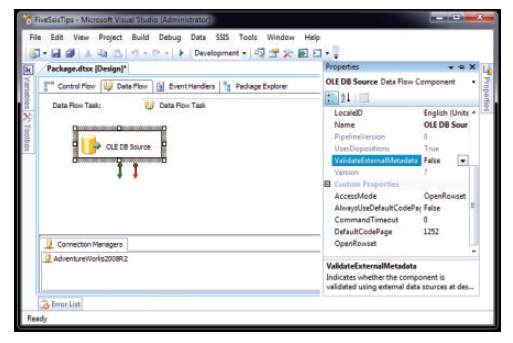| Inside SQL Server Pro Magazine November 2013 |
| Written by Ian Stirk | |||
| Tuesday, 12 November 2013 | |||
|
Improve your SQL Server Integration Services experience with the tips given in the November issue of SQL Server Pro Magazine. SQL Server Pro (www.sqlmag.com) is an online subscription-based monthly magazine. In this review the items in bold below correspond to the name of the article in his month's issue. My favourite article this month was 5 Tips for Developing SQL Server Integration Services Packages, in which Robert Sheldon offers tips relating to:
The article is well written, detailed and makes good use of screenshots.
None of the tips is earth-shattering, but each will certainly make your SSIS development more pleasing. So, while the article doesn't contain anything radical, it will surely improve the way you use SSIS. Sometimes you may need to debug a stored procedure in the context of its client application, for example when the parameters are not known, or the system interaction is complex. With this in mind, William Sheldon presents Debugging Stored Procedures in Visual Studio 2010. The article provides a detailed step-by-step guide to debugging from the client application through to the stored procedures via Visual Studio 2010. This is definitely an article to bookmark for future reference.
The Intervals and counts series continues with Part 3. In this article Itzik Ben-Gan focuses on calculating the maximum count of concurrent sessions within each fixed hourly period. The first solution provided uses a windows function that applies a running total aggregate. The solution is then enhanced, by using an artificial cross join to produce a parallel plan. The final solution involves using computed columns that hold floored timestamps. If you need to analyse counts within fixed periods, this article is exactly what you need! This series is available on the website without needing a subscription to the magazine and the onlne version is already at Part 4 with links to the earlier parts. The corruption series continues with Checksum Page Verification. This database setting is used to identify corruption problems early. In essence, when data is written to disk a checksum value is calculated and written, when the data page is subsequently read, the checksum is again calculated and compared to its original value, any discrepancy is reported as corruption. Perhaps the article could have mentioned that details of any corrupt pages are reported in the msdb.dbo.suspect_pages table. Additionally, nothing was said about the slight performance penalty for enabling this setting – CPU performance is typically increased by up to 2%. That said, I feel the benefits of this setting certainly exceed the costs. In Microsoft Faces Uncertain Times, Michael Otey discusses the recent changes Microsoft has undergone, including the CEO stepping down in the near future, the purchase of Nokia, and various unpopular IT changes (Windows 8 anyone?!). It does appear Microsoft has garnered a “We know best” attitude of late, only to make retractions later – perhaps it really is time for Microsoft to listen and take note of its customers concerns. Perhaps the major reason given for upgrading to SQL Server 2012 was the enhanced high availability and disaster recovery capabilities provided by AlwaysOn Availability Groups. In Changes to SQL Server 2014 AlwaysOn Availability Groups the forthcoming improvements are highlighted, these include:
In A Better Way to Enable Email Alerts for Deadlocks, Michael K. Campbell supplies a script that uses performance conditions to specify alert logic, but specifically for deadlocks. The article is rather short, I suspect the script could have been extended for other conditions to make a more useful article. This month’s magazine felt a little short on content, I’m not entirely sure why, maybe it’s because there are a few series running, so it doesn’t feel like there’s a lot of new material. Still overall, there’s a good range of subject matter covered.
More InformationRelated ArticlesData Mining Explored In SQL Server Pro Magazine (October issue) Looking Forward to SQL Server 2014 (September issue) SQL Server Pro's Tips For Performance Tuning and T-SQL (August issue) PowerShell The SQL Server Way (July issue) T-SQL Join Types In SQL Server Pro's June Issue
To be informed about new articles on I Programmer, install the I Programmer Toolbar, subscribe to the RSS feed, follow us on, Twitter, Facebook, Google+ or Linkedin, or sign up for our weekly newsletter.
Comments
or email your comment to: comments@i-programmer.info
|
|||
| Last Updated ( Tuesday, 10 December 2013 ) |




